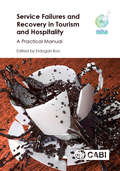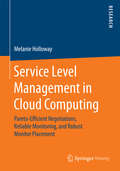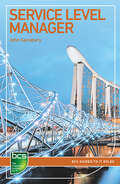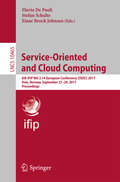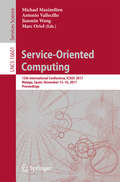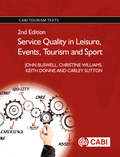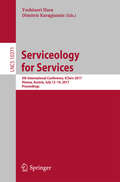- Table View
- List View
Servant Leadership and Followership: Examining the Impact on Workplace Behavior
by Crystal J. DavisProviding a deeper understanding of leadership, followership theory, and the follower as servant leader, this book provides employee and follower perspectives of servant leadership in the workplace. The collection brings together both empirical and conceptual research from around the globe to illustrate how the leader is seen through the lens of the follower. Topics discussed include organizational performance, empowerment, competency models, diversity in the workplace, and social roles and stereotypes. With contributions from a range of skilled authors, Servant Leadership and Followership not only provides an overview of servant leadership, but also offers insightful ways for organizations to adapt and progress in line with the shifting moral demands of today’s workplace.
Servant Leadership and Followership: Examining the Impact on Workplace Behavior
by Crystal J. DavisProviding a deeper understanding of leadership, followership theory, and the follower as servant leader, this book provides employee and follower perspectives of servant leadership in the workplace. The collection brings together both empirical and conceptual research from around the globe to illustrate how the leader is seen through the lens of the follower. Topics discussed include organizational performance, empowerment, competency models, diversity in the workplace, and social roles and stereotypes. With contributions from a range of skilled authors, Servant Leadership and Followership not only provides an overview of servant leadership, but also offers insightful ways for organizations to adapt and progress in line with the shifting moral demands of today’s workplace.
Servant Leadership and Followership: Examining the Impact on Workplace Behavior
by Crystal J. DavisProviding a deeper understanding of leadership, followership theory, and the follower as servant leader, this book provides employee and follower perspectives of servant leadership in the workplace. The collection brings together both empirical and conceptual research from around the globe to illustrate how the leader is seen through the lens of the follower. Topics discussed include organizational performance, empowerment, competency models, diversity in the workplace, and social roles and stereotypes. With contributions from a range of skilled authors, Servant Leadership and Followership not only provides an overview of servant leadership, but also offers insightful ways for organizations to adapt and progress in line with the shifting moral demands of today’s workplace.
Service Business Model Innovation in Healthcare and Hospital Management: Models, Strategies, Tools
by Mario A. Pfannstiel Christoph RascheThis book demonstrates how to successfully manage and lead healthcare institutions by employing the logic of business model innovation to gain competitive advantages. Since clerk-like routines in professional organizations tend to overlook patient and service-centered healthcare solutions, it challenges the view that competition and collaboration in the healthcare sector should not only incorporate single-end services, therapies or diagnosis related groups. Moreover, the authors focus on holistic business models, which place greater emphasis on customer needs and put customers and patients first. The holistic business models approach addresses topics such as business operations, competitiveness, strategic business objectives, opportunities and threats, critical success factors and key performance indicators.The contributions cover various aspects of service business innovation such as reconfiguring the hospital business model in healthcare delivery, essential characteristics of service business model innovation in healthcare, guided business modeling and analysis for business professionals, patient-driven service delivery models in healthcare, and continuous and co-creative business model creation. All of the contributions introduce business models and strategies, process innovations, and toolkits that can be applied at the managerial level, ensuring the book will be of interest to healthcare professionals, hospital managers and consultants, as well as scholars, whose focus is on improving value-generating and competitive business architectures in the healthcare sector.
Service Failures and Recovery in Tourism and Hospitality: A Practical Manual
by Aybeniz Akdeniz Ar Umut Avci Gulnil Aydin Melissa A. Baker Kemal Birdir Huey Chern Boo Hakan Boz Ugur Caliskan Celil Cakici Ali Dalgic Christina K. Dimitriou Mariangela Franch Ozan Guler Jong-Hyeong Anna Irimiás Petranka Kelly Kawon Kim Erdogan Koc Jennifer Lawlor Minwoo Lee Poh Theng Loo Gábor Michalkó Michael Mulvey Isil Arikan Saltik Dallen J Timothy Derya ToksözTourism and hospitality services are highly prone to service-failure due to a high level of customer-employee contact and the inseparable, intangible, heterogeneous and perishable nature of these services. Service Failures and Recovery in Tourism and Hospitality, with its extensive coverage of the literature, presents an invaluable source of information for academics, students, researchers and practitioners. In addition to its extensive coverage of the literature in terms of recent research published in top tier journals, chapters in the book contain student aids, real-life examples, case studies, links to websites and activities alongside discussion questions and presentation slides for in-class use by teaching staff. This book is enhanced with supplementary resources. The customizable lecture slides can be found at: www.cabi.org/openresources/90677
Service Level Management in Cloud Computing: Pareto-Efficient Negotiations, Reliable Monitoring, and Robust Monitor Placement
by Melanie HollowayMelanie Holloway explores a cloud broker offering service level agreement negotiation and monitoring as a service to consumers. She proposes a negotiation mechanism, which enables the achievement of economically efficient agreements, and an approach for reliable consumer side availability monitoring in conjunction with strategies for robust monitor placement. The author addresses the loss of control of consumers over critical aspects, specifically quality of service, when using services from the cloud.Basically, the cloud computing paradigm places the responsibility for resource management on the provider side. Hence, the control over cloud service performance is very limited on the consumer side.
Service Level Manager: Careers in IT service management (Bcs Guides To It Roles Ser.)
by John SansburyThe role of service level manager is a critical one in that the agreements negotiated with customers should inform the activities of the service provider. This book aims to help those whose role is to establish, negotiate, manage or update service level agreements and to use these as the basis of continual service improvement. It covers areas such as purpose, required skills, responsibilities, interface and career progression as well as tools, standards and frameworks related to the role.
Service Level Manager: Careers in IT service management (Bcs Guides To It Roles Ser.)
by John SansburyThe role of service level manager is a critical one in that the agreements negotiated with customers should inform the activities of the service provider. This book aims to help those whose role is to establish, negotiate, manage or update service level agreements and to use these as the basis of continual service improvement. It covers areas such as purpose, required skills, responsibilities, interface and career progression as well as tools, standards and frameworks related to the role.
Service-Oriented and Cloud Computing: 6th IFIP WG 2.14 European Conference, ESOCC 2017, Oslo, Norway, September 27-29, 2017, Proceedings (Lecture Notes in Computer Science #10465)
by Flavio De Paoli Stefan Schulte Einar Broch JohnsenThis book constitutes the refereed proceedings of the 6th IFIP WG 2.14 European Conference on Service-Oriented and Cloud Computing, ESOCC 2017, held in Oslo, Norway, in September 2017. The 6 short and 10 full papers presented in this volume were carefully reviewed and selected from 37 submissions. The volume also contains one invited talk in full paper length. The contributions were organized in topical sections named: microservices and containers; security; cloud resources; services; internet of things and data streams; and industrial applications of service and cloud computing.
Service-Oriented Computing: 15th International Conference, ICSOC 2017, Malaga, Spain, November 13–16, 2017, Proceedings (Lecture Notes in Computer Science #10601)
by Michael Maximilien, Antonio Vallecillo, Jianmin Wang and Marc OriolThis book constitutes the proceedings of the 15th International Conference on Service-Oriented Computing, ICSOC 2017, held in malaga, Spain, in November 2017. The 33 full papers presented together with 20 short papers and 4 keynotes in this volume were carefully reviewed and selected from 179 submissions.The selected papers cover a wide variety of important topics in the area of service-oriented computing, including foundational issues on service discovery and service-systems design, business process modelling and management, economics of service-systems engineering, as well as services on the cloud, social networks, the Internet of Things (IoT), and data analytics.The chapter "Risk-based Proactive Process Adaptation" is available open access under a CC BY 4.0 license via link.springer.com.
Service Quality in Leisure, Events, Tourism and Sport (CABI Tourism Texts)
by John Buswell Christine Williams Keith Donne Carley SuttonService quality is at the forefront of how the leisure, events, tourism and sport (LETS) sectors operate. An important consideration for any business, and therefore any student of the subject, this new edition of a successful textbook addresses the key points and principles of managing service quality across the industry sector. Fully updated and enhanced, it: - Covers areas such as the experience economy, capacity management and service culture, as well as methods for measuring quality and satisfaction. - Includes numerous case studies to help students apply classroom-based theory to practice. - Is packed with student-friendly pedagogy and full colour illustrations throughout to enhance the learning experience. Considering the underpinning theory of service quality, this book informs the reader of the practical application of service quality management tools and techniques in an industry with distinctive features and challenges. An invaluable read for students within the LETS sectors, it also provides a useful refresher for practitioners working in the industry.
Serviceology for Services: 5th International Conference, ICServ 2017, Vienna, Austria, July 12-14, 2017, Proceedings (Lecture Notes in Computer Science #10371)
by Yoshinori Hara Dimitris KaragiannisThis book constitutes the refereed proceedings of the 5th International Conference on Serviceology for Services, held in Vienna, Austria, in July 2017. The 21 full papers and one tutorial paper presented in this volume were carefully reviewed and selected from 75 submissions. The papers are organized around the following topics: human-centered service; customer satisfaction; service innovation and marketing; service design.
Serviceology for Smart Service System: Selected papers of the 3rd International Conference of Serviceology
by Yuriko Sawatani Takeshi Takenaka James Spohrer Stephen KwanServices are key activities in a globalized economy and they also underlie the quality of life of local residents. The advanced work presented in this book was selected from the proceedings of the Third International Conference on Serviceology (ICServ2015), held July 7–9, 2015, in San Jose, CA, USA. The conference was supported by the Society for Serviceology. The society was established in 2012 in Japan to explore the scientific systematization of services and to promote technological developments for solutions to industrial issues.This book provides a useful general guide to the state of the art in the theory and practice of services. It can also serve as a valuable reference book for researchers in a wide range of fields from engineering to marketing and economics.
Services Marketing Cases in Emerging Markets: An Asian Perspective
by Sanjit Kumar Roy Dilip S. Mutum Bang NguyenThis casebook provides students and academics in business management and marketing with a collection of case studies on services marketing and service operations in emerging economies. It explores current issues and practices in Asia, across different areas, countries, commercial and non-commercial sectors. This book is important and timely in providing a framework for instructors, researchers, and students to understand the service dynamics occurring in these countries. It serves as an invaluable resource for marketing and business management students requiring insights into the operationalization of services across different geographical areas in Asia. Students will find it interesting to compare and contrast different markets covering important aspects related to services.
Setting Agendas in Cultural Markets: Organizations, Creators, Experiences (Routledge Research in Communication Studies)
by Philemon BantimaroudisThis book draws on agenda setting theory to examine how cultural organizations relate to media in order to increase their visibility, valence, and eventually build their public image. Most organizations have a keen interest in their symbolic presence, as their media visibility influences public knowledge, perceptions and even behaviors. Diminished public funding, in combination with the global proliferation of cultural entities, creates a competitive environment, leading to a transformation of cultural industries. In the book, several questions are under scrutiny: How do cultural organizations acquire symbolic significance? How do they become prominent in media content? Which mechanisms and processes should be examined by cultural managers as they set out to achieve salience? Is there a relationship between media and public salience? In other words, if an organization becomes symbolically prominent, in what ways is the public influenced, both in terms of perceptions as well as behaviors?
Setting Agendas in Cultural Markets: Organizations, Creators, Experiences (Routledge Research in Communication Studies)
by Philemon BantimaroudisThis book draws on agenda setting theory to examine how cultural organizations relate to media in order to increase their visibility, valence, and eventually build their public image. Most organizations have a keen interest in their symbolic presence, as their media visibility influences public knowledge, perceptions and even behaviors. Diminished public funding, in combination with the global proliferation of cultural entities, creates a competitive environment, leading to a transformation of cultural industries. In the book, several questions are under scrutiny: How do cultural organizations acquire symbolic significance? How do they become prominent in media content? Which mechanisms and processes should be examined by cultural managers as they set out to achieve salience? Is there a relationship between media and public salience? In other words, if an organization becomes symbolically prominent, in what ways is the public influenced, both in terms of perceptions as well as behaviors?
Setting Up a Successful Jewellery Business
by Angie BoothroydAn updated edition of the best-selling handbook, this all-encompassing guide for jewellery entrepreneurs of all levels covers key lessons for setting up, running and growing a jewellery business.From the college graduate looking to set up a workshop, to the established maker ready to expand their business, Setting up a Successful Jewellery Business equips creative jewellers with the essential knowledge and tools to operate a professional jewellery business.Encouraging individuals to define their business objectives and strategy for the future, the guide deals with topics including:· presenting your brand;· protecting your designs;· how much to charge for your work;· selling to shops, galleries and individuals;· creating your website and driving traffic to it;· managing your time and finances plus other essential business skills.Updated with two new chapters, an expanded section on social media and a revised appendix, this is an indispensable jeweller's companion that provides the resources to take your business forward.
Setting Up a Successful Jewellery Business
by Angie BoothroydAn updated edition of the best-selling handbook, this all-encompassing guide for jewellery entrepreneurs of all levels covers key lessons for setting up, running and growing a jewellery business.From the college graduate looking to set up a workshop, to the established maker ready to expand their business, Setting up a Successful Jewellery Business equips creative jewellers with the essential knowledge and tools to operate a professional jewellery business.Encouraging individuals to define their business objectives and strategy for the future, the guide deals with topics including:· presenting your brand;· protecting your designs;· how much to charge for your work;· selling to shops, galleries and individuals;· creating your website and driving traffic to it;· managing your time and finances plus other essential business skills.Updated with two new chapters, an expanded section on social media and a revised appendix, this is an indispensable jeweller's companion that provides the resources to take your business forward.
The Seventh Sense: Power, Fortune, and Survival in the Age of Networks
by Joshua Cooper RamoEndless terror. Refugee waves. An unfixable global economy. Surprising election results. New billion-dollar fortunes. Miracle medical advances. What if they were all connected? What if you could understand why? The Seventh Sense is the story of what all of today's successful figures see and feel: the forces that are invisible to most of us but explain everything from explosive technological change to uneasy political ripples. The secret to power now is understanding our new age of networks. Not merely the Internet, but also webs of trade, finance, and even DNA. Based on his years of advising generals, CEOs, and politicians, Ramo takes us into the opaque heart of our world's rapidly connected systems and teaches us what the losers are not yet seeing -- and what the victors of this age already know.
Shadow Banking and the Rise of Capitalism in China
by Andrew CollierThis book is about the growth of shadow banking in China and the rise of China’s free markets. Shadow Banking refers to capital that is distributed outside the formal banking system, including everything from Mom and Pop lending shops to online credit to giant state owned banks called Trusts. They have grown from a fraction of the economy ten years ago to nearly half of all China’s annual Rmb 25 trillion ($4.1 trillion) in lending in the economy today. Shadow Banks are a new aspect of capitalism in China – barely regulated, highly risky, yet tolerated by Beijing. They have been permitted to flourish because many companies cannot get access to formal bank loans. It is the Wild West of banking in China. If we define capitalism as economic activity controlled by the private sector, then Shadow Banking is still in a hybrid stage, a halfway house between the state and the private economic. But it is precisely this divide that makes Shadow Banking an important to the rise of capitalism. How Beijing handles this large free market will say a lot about how the country’s economy will grow – will free markets be granted greater leeway?
Shadow Banking and the Rise of Capitalism in China
by Andrew CollierThis book is about the growth of shadow banking in China and the rise of China’s free markets. Shadow Banking refers to capital that is distributed outside the formal banking system, including everything from Mom and Pop lending shops to online credit to giant state owned banks called Trusts. They have grown from a fraction of the economy ten years ago to nearly half of all China’s annual Rmb 25 trillion ($4.1 trillion) in lending in the economy today. Shadow Banks are a new aspect of capitalism in China – barely regulated, highly risky, yet tolerated by Beijing. They have been permitted to flourish because many companies cannot get access to formal bank loans. It is the Wild West of banking in China. If we define capitalism as economic activity controlled by the private sector, then Shadow Banking is still in a hybrid stage, a halfway house between the state and the private economic. But it is precisely this divide that makes Shadow Banking an important to the rise of capitalism. How Beijing handles this large free market will say a lot about how the country’s economy will grow – will free markets be granted greater leeway?
Shaping EU Public Procurement Law: A Critical Analysis of the CJEU Case Law 2015-2017
by Albert Sanchez-Graells Constant De KoninckThe first part of the book offers a unique reflection on enduring themes in public procurement law such as the shaping of the scope of this regulatory regime, the development of tighter criteria for the exclusion of candidates and tenderers, the conduct of qualitative selection, the consolidation of the court’s previous approach to technical specifications, new developments in tender evaluation, the inclusion of contract performance clauses with a social orientation, and, last but not least, the development of interpretive guidance concerning several aspects of the procurement remedies regime. The book shows that the period 2015–2017 has been an interesting and rather intense period for the development of EU public procurement law, where the CJEU has not only consolidated some parts of its long-standing procurement case law but also introduced significant innovations that can create future challenges for the consistency of this regulatory regime. The first part of the book concludes with some thoughts on some of the salient aspects of this recent episode of silent reform of EU public procurement law through CJEU case law. The second part of the book contains the essential excerpts of forty-one chronologically ordered judgments issued by the CJEU in the period 2015–2017, which have been selected because they either raise new issues or important matters of public procurement law. Each of the selected judgments is followed by an exhaustive and critical in-depth analysis, highlighting and providing insight into its legal and practical issues and consequences. An exhaustive subject-index offers the reader quick and easy access to the case law treated in this book. This unique book, a ‘must-have’ reference work for judges and courts of all EU Member States and candidate countries and academics and legal professionals who are active in the field of procurement law, will also be valuable for law libraries and law schools across the world and for law students who focus their research and studies on EU law.
Shaping Inclusive Workplaces Through Social Dialogue (Industrial Relations & Conflict Management)
by Alicia Arenas Donatella Di Marco Lourdes Munduate Martin C. EuwemaThis book presents Social Dialogue as a social innovation strategy for managing diversity at any step of the human resource circle. It showcases empirical research on how to improve open dialogue and constructive negotiations between management, trade unions and employee representatives using multi-disciplinary perspectives from psychology, business, law, gender studies, sociology and management. This book delivers the latest research to promote a change of attitudes, behaviors and competences on diversity and social inclusion, and develop effective organizational responses in terms of policies and procedural aspects to improve inclusion of vulnerable groups at work. The authors and editors explain effective development tools for an inclusive workplace through Social Dialogue, showing that it is possible to achieve this by integrating values, policies and practices at organizational level. The diversity of contributions from different organizational contexts, countries and cultures results in this being a valuable book for a wide range of scientists, researchers, students and human resource managers as they seek to shape inclusive workplaces through Social Dialogue.
Shaping Social Enterprise: Understanding Institutional Context and Influence
by Janelle A. Kerlin‘Shaping Social Enterprise’ offers the first tested framework that helps identify institutional influences affecting social enterprise. For well over a decade, scholars and practitioners have known that social enterprise looks different in different contexts but few have attempted to understand why. Kerlin’s work in this area is the first to consider the influence of large institutions such as government, economy, civil society, and culture on the development of social enterprise. This book provides an in-depth assessment of Kerlin’s theoretically-based framework for understanding these institutional and other influences by means of quantitative analysis as well as qualitative critiques from eight countries that help validate and refine it. The concluding chapter offers a revision of the framework based on the critiques. New features include more attention to culture and micro- and meso-level forces as well as the introduction of optional framework components that address rarely occurring country situations. Two new social enterprise country models are also added and new applications of the framework are detailed.
Shaping Social Enterprise: Understanding Institutional Context and Influence
by Janelle A. Kerlin‘Shaping Social Enterprise’ offers the first tested framework that helps identify institutional influences affecting social enterprise. For well over a decade, scholars and practitioners have known that social enterprise looks different in different contexts but few have attempted to understand why. Kerlin’s work in this area is the first to consider the influence of large institutions such as government, economy, civil society, and culture on the development of social enterprise. This book provides an in-depth assessment of Kerlin’s theoretically-based framework for understanding these institutional and other influences by means of quantitative analysis as well as qualitative critiques from eight countries that help validate and refine it. The concluding chapter offers a revision of the framework based on the critiques. New features include more attention to culture and micro- and meso-level forces as well as the introduction of optional framework components that address rarely occurring country situations. Two new social enterprise country models are also added and new applications of the framework are detailed.


